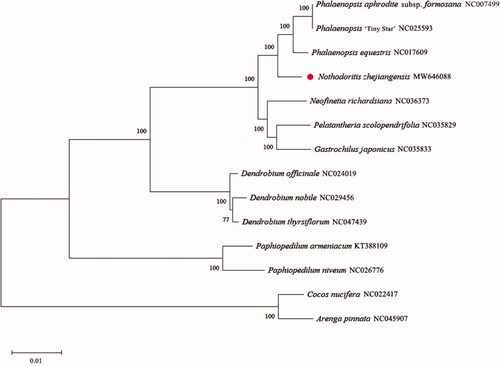Abstract
Nothodoritis zhejiangensis (Orchidaceae) is a rare orchid unique to China of great horticultural value. The complete chloroplast (cp) genome of this species is 143,522 bp in length and the total GC content is 36.8%. It includes a large single copy (LSC) region of 83,830 bp in length, a small single copy (SSC) region of 10,764 bp, and a pair of inverted repeat regions (IRs) with 24,464 bp. The cp genome contains 120 functional genes, including 74 protein-coding genes, 38 tRNA genes, and eight rRNA genes. The phylogenetic tree constructed by the maximum-likelihood method showed that the taxonomic status of N. zhejiangensis was clustered with the species in Phalaenopsis.
Nothodoritis zhejiangensis Z. H. Tsi., a rare orchid species unique to China, is narrowly distributed in Lin'an (Zhejiang), Kangxian (Gansu), Zhenping (Shaanxi), Huangshan (Anhui) (Tsi Citation1989; Zeng et al. Citation2011). It is epiphytic on tree branches in forests or at forest margins at elevation 300–900 m (Chen and Wood Citation2009). N. zhejiangensis is universally recognized as an ornamental plant on great horticultural value (Zeng et al. Citation2011). However, due to the perennial digging and destruction of habitat, the populations of N. zhejiangensis are extremely sparser, and it has been included in the China Species Red List (Wang and Xie Citation2004) and Plant Species with Extremely Small Population (PSESP) of China (Wade et al. Citation2016). To better understand its taxonomic status and further help the conservation of N. zhejiangensis, we reported its chloroplast (cp) genome structure firstly, and a maximum-likelihood phylogenetic tree was constructed for phylogenomic analysis.
Fresh leaf material was sampled from a living individual, which was taken from Kuzhuxi, Tangkou, Anhui Province (N30°05′50.2″, E118°12′42.9″). Voucher specimens (BFU-ORCHID-2017022) was stored in the herbarium of Plant Biology Department (Wu Qi, [email protected]), Beijing Forestry University. CTAB method (Doyle and Doyle Citation1987) was employed to extract the total genomic DNA, and the Illumina HiSeq Xten platform at oebiotech (https://www.oebiotech.com/, China) was used to perform 350 bp pair-end sequencing. GetOrganelle V1.7.1 (Jin Citation2020) program was used to De Novo assemble the cp genome of clean data; using Geneious 2021.0.3 (https://www.geneious.com/) for preliminary annotation and Plann V1.1.2 (Huang and Cronk Citation2015) for complete cp genome annotation. We submitted the complete cp genome sequence to GenBank and got the accession number MW646088.
The complete cp genome sequence of N. zhejiangensis has a typical ring structure with the length of 143,522 bp and the total GC content of 36.8%. It includes a large single copy (LSC) region of 83,830 bp in length, a small single copy (SSC) region of 10,764 bp, and a pair of inverted repeat regions (IRs) with 24,464 bp. The annotated cp genome contains 120 functional genes, including 74 protein-coding genes, 38 tRNA genes, and eight rRNA genes. Among them, 10 protein-coding genes (rps16, atpF, ropC1, ycf3, clpP, petB, petD, rpl16, rpl2, rps12) and six tRNA genes (trnK-UUU, trnR-UCC, trnL-UAA, trnV-UAC, trnI-GAU, trnA-UGC) have introns.
To confirm the phylogenetic position of N. zhejiangensis, a maximum-likelihood phylogenetic tree was constructed with the complete cp genome of N. zhejiangensis, which also contained 11 related species and two outgroups. All the sequences were used MAFFT V7.309 for multiple sequence alignment (Katoh and Standley Citation2013). MAGE-X was used to construct a phylogenetic tree (Kumar et al. Citation2018) under the GTR + G model, with bootstrap percentages computed after 1000 replicates. The results of the phylogenetic tree showed that N. zhejiangensis was sister to genus of Phalaenopsis (), which was consistent with previous studies (Tsi Citation1999; Christenson Citation2001). The cp sequence of N. zhejiangensis will provide a valuable reference for studies on the genetic diversity in Orchidaceae.
Disclosure statement
No potential conflict of interest was reported by the authors.
Data availability statement
The genome sequence data that support the findings of this study are openly available in GenBank of NCBI at https://www.ncbi.nlm.nih.gov/nuccore/MW646088 under the accession no. MW646088. The associated BioProject, SRA, and Bio-Sample numbers are PRJNA740166, SRR14887006, and SAMN19822037, respectively.
Additional information
Funding
References
- Chen XQ, Wood JJ. 2009. Nothodoritis Z. H. Tsi. In: Wu ZY, Raven PH, Hong DY, editors. Flora of China. Vol. 25. Beijing/St. Louis: Science Press/Missouri Botanical Garden Press.
- Christenson EA. 2001. Phalaenopsis: a monograph. Portland: Timber Press.
- Doyle JJ, Doyle JL. 1987. A rapid DNA isolation procedure for small quantities of fresh leaf tissue. Phytochem Bull. 19:11–15.
- Huang DI, Cronk QC. 2015. Plann: a command-line application for annotating plastome sequences. Appl Plant Sci. 3:1500026.
- Jin JJ, Yu WB, Yang JB, Song Y, dePamphilis CW, Yi TS, Li DZ. 2020. GetOrganelle: a fast and versatile toolkit for accurate de novo assembly of organelle genomes. Genome Biol. 21(1):241.
- Katoh K, Standley DM. 2013. MAFFT multiple sequence alignment software version 7: improvements in performance and usability. Mol Biol Evol. 30(4):772–780.
- Kumar S, Stecher G, Li M, Knyaz C, Tamura K. 2018. MEGA X: molecular evolutionary genetics analysis across computing platforms. Mol Biol Evol. 35(6):1547–1549.
- Tsi ZH. 1989. Nothodoritis Tsi—a new genus of Orchidaceae from China. Acta Phytotaxon Sin. 27:58–61.
- Tsi ZH, Chen XQ, Luo YB, Zhu GH. 1999. Nothodoritis Z. H. Tsi. In: Editorial Committee of Chinese Flora, Chinese Academy of Sciences. Flora Republicae Popularis Sinicae. Vol. 19. Beijing: Science Press.
- Wade EM, Nadarajan J, Yang X, Ballesteros D, Sun WB, Pritchard WH. 2016. Plant species with extremely small populations (PSESP) in China: a seed and spore biology perspective. Plant Divers. 38(5):209–220.
- Wang S, Xie Y. 2004. China Species Red List. Beijing: High Education Press.
- Zeng SJ, Chen ZL, Wu KL, Zhang JX, Bai CK, da Silva JAT, Duan J. 2011. Asymbiotic seed germination, induction of calli and protocorm-like bodies, and in vitro seedling development of the rare and endangered Nothodoritis zhejiangensis Chinese orchid. HortScience. 46(3):460–465.

